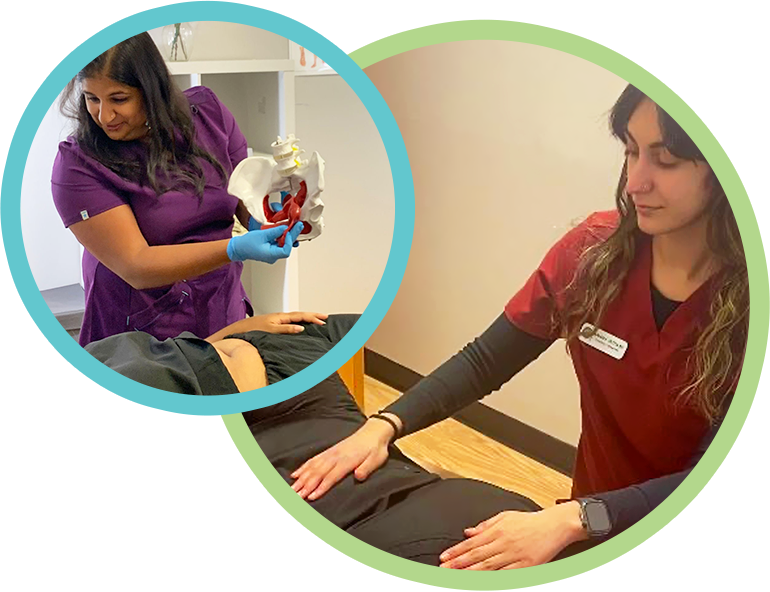Pelvic Floor Physical Therapy
Innovative Physical Therapy and Fitness Center currently offers the most advanced and innovative treatment techniques on Pelvic Floor Health all genders at our facilities in Kendall Park, NJ and Princeton NJ.
What Is the Pelvic Floor?
The pelvic floor refers to the group of muscles that support your pelvis, reproductive organs, and the colorectal and urinary tracts, including your bladder, uterus (female), prostate (male), and rectum. These muscles attach to your pelvic bones and wrap around the urethra and rectum like a hammock to provide support. In addition to providing support, they also help with the regulation of normal bladder and bowel function.

What Happens if there is Pelvic Floor Dysfunction?
When these muscles aren’t working as they should, they can cause pain and other symptoms that interfere with daily functioning. Dysfunction in pelvic floor can cause:
Urinary dysfunction
Urinary leakage, Urinary urgency and frequency, Painful voiding, difficulty starting or stopping urination, and difficulty emptying the bladder. Many of these symptoms are also associated with Interstitial cystitis (IC), also known as painful bladder syndrome.
Bowel dysfunction
Constipation, bowel urgency and frequency, fecal and or flatus incontinence, chronic diarrhea, pain with bowel evacuation, and feelings of incomplete emptying. Some other associated GI conditions like IBS, bloating, excess gas/burping, and gastroparesis can also be common.
Female Athletes
All age female athletes are at higher risk for pelvic floor dysfunction due to the increased and repeated downward force on the pelvic floor musculature. In these affected young female athletes, there is also an increased risk for related menstrual disturbances and bone mineral density changes. The most common sports to experience pelvic floor dysfunction are gymnasts, dancers, ice skaters, and runners, but it can be seen in any competitive sport.
Endometriosis
Endometriosis occurs when the endometrium, or lining of the uterus, grows outside of the uterus in the pelvis and abdomen. Patients suffering from endometriosis can also experience dysfunction in their pelvic floor. Chronic pain can cause trauma to the muscles, ligaments, nerves, and fascia of the pelvis and abdominal wall. This can result in pain in the pelvis, difficulty urinating, difficulty having bowel movements, painful sex, and pain with movement. Pelvic floor therapy directly targets the pelvic floor to improve patients’ symptoms.
Pelvic pain
Pain in the genital region and/or rectum, lower abdomen, low back, tailbone, and or buttocks may be a result of overactive pelvic floor musculature. Musculoskeletal pelvic pain is also highly reported during pregnancy and postpartum.
Pelvic organ prolapse
Pelvic organ prolapse happens when the pelvic muscles and tissues can no longer support these organs because the muscles and tissues are weak or damaged. Pelvic organ prolapse is often associated with pain during intimacy, during bowel and bladder evacuation, and even during daily activity and exercise.
Pediatric pelvic floor dysfunction
Children can also experience pelvic floor dysfunction. Childhood constipation can lead to leaking and pain. Young girls often experience loss of small amounts of urine with giggling and or being tickled. Children with sensory processing disorders can associate voiding their bladder or bowel with pain and may cause retention issues.
Sexual dysfunction in all genders
Pelvic floor disorders have been shown to be associated with dyspareunia, or painful insertion. Dyspareunia can be primary, which is since first attempt (intercourse/ gynecological exam/tampon insertion), or secondary, which can be new onset without a past pain history. The latter is very common postpartum, after menopause, and after the result of trauma (surgery, cancer treatment, falls, assault, etc). Men can experience pain with erection, ejaculation, and afterwards. There can also be pelvic pain and voiding dysfunction following gender reassignment surgery that can interfere with daily activity.
Other Special Populations Pelvic PTs Treat
PT during Pregnancy
Preparing your body for the birthing process should include a visit with a Pelvic Floor Physical Therapist (PFPT). 85% of women will experience back or pelvic pain during pregnancy, and if pain goes unanswered it can increase risks for postpartum depression. PT can help educate on body mechanics during pregnancy, labor positions, manual techniques to decrease the chances of perineal tears and the length of labor, and immediate postpartum care. We can also equip you with education on what you can do postpartum before you are cleared to resume exercise.
Postnatal Conditions
After a vaginal or cesarean delivery, the pelvic floor may need some cueing to appropriately activate again. If not activated this can lead to Pelvic Floor Dysfunction. Some postpartum topics that may be discussed include effects of labor, screening for diastasis rectus abdominis, pelvic organ prolapse, and musculoskeletal pain that may have arisen during pregnancy or delivery.
Lymphedema
A persistent swelling of the arms or legs which may occur after a mastectomy, other surgeries, radiation, scar formation and other causes which block the lymphatic flow. Complete Decongestive Physiotherapy (CDP) is a non-invasive treatment that consists of manual lymph drainage, compression bandaging, therapeutic exercise and skin care.
Physical Therapy Techniques
Physical therapy techniques may include but are not limited to:
- Manual therapy
- Internal Manual Pelvic Therapy
- Holding gentle pressure while the patient focused on relaxing and breathing
- Holding gentle pressure while the patient performs a contact/relax of the muscles or a pelvic floor bulge.
- Holding gentle pressure while simultaneously pressing with the opposite hand on a point around the pelvis to produce slack in the muscle (a modified strain counter strain technique).
- Sweeping stretches over the muscle belly
- Vaginal or rectal trigger point releases (After verbal and written consent provided by the patient)
- Self-care and management strategies
What Is Internal Manual Therapy?
Internal manual therapy techniques are a treatment used for someone who has overactive, tender and/or shortened pelvic floor muscles.Tender or overactive pelvic floor muscles can occur when someone is experiencing problems like pelvic pain, painful sexual intercourse, tailbone pain, as well as urinary or bowel dysfunction. These techniques are performed either vaginally or rectally by a skilled medical practitioner who has undergone advanced training to learn to evaluate and treat the pelvic floor muscles. They are only performed once the patient has been thoroughly educated about the treatment techniques and consents to participating in the treatment.
What Does Treatment Involve?
The goal of internal manual therapy is to improve the relaxation, lengthening and tenderness of the pelvic floor muscles. Generally, the patient is first positioned comfortably in either hooklying (on their back with knees bent, sometimes resting on a pillow sidelying or sometimes on their stomach, depending on what position is preferable to the patient and allows the therapist access to the tissues being treated. The therapist then places one gloved finger within the vaginal or rectal canal and gently presses on the muscles of the pelvic floor to identify (with constant feedback from the patient) where the muscles are tender or uncomfortable. Manual therapy techniques then can be performed to help improve the tenderness of these muscles and promote relaxation and lengthening. These techniques can include:
Different therapists have different approaches, but they all are done in complete collaboration and communication with the patient and are modified based on the patient’s comfort and response to the treatment.
- Strengthening exercises such as Kegels and coordination with abdominal and hip and back musculature
- Electrical stimulation, Biofeedback or surface electromyography (EMG)
Meet Our Pelvic Floor Physical Therapists

Aditi Chandan
PT, DPT, CLT, WCS
Aditi Chandan PT, DPT, CLT, WCS
Dr Aditi Chandan is a NJ transplant hailing from Western NY. She gained her Bachelor of Science from SUNY-Buffalo in Buffalo NY, and earned her Doctorate of Physical Therapy (DPT) at the University of Hartford in West Hartford CT in 2012. After that she spent 6 years in TX where she worked as part of the Baylor Scott & White Rehabilitation system and completed a 14-month post-professional residency in all genders’ Health Pelvic Physical Therapy management, including certification as a lymphedema therapist (CLT). Following residency, she received her national Board certification as a Pelvic Health Specialist in Physical Therapy.
Aditi is specialized in the treatment and rehabilitation of pelvic floor dysfunction, constipation, fecal incontinence, urinary incontinence, obstetrics/post-partum therapy, gender transitioning, osteoporosis, rheumatoid arthritis, lymphedema, oncology management, and fibromyalgia/chronic pain.

Rupa Patel
PT, DPT Cert. MDT, PCES
- Kendall Park
- Edison
- Princeton
- Old Bridge
- Monroe

